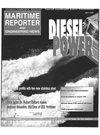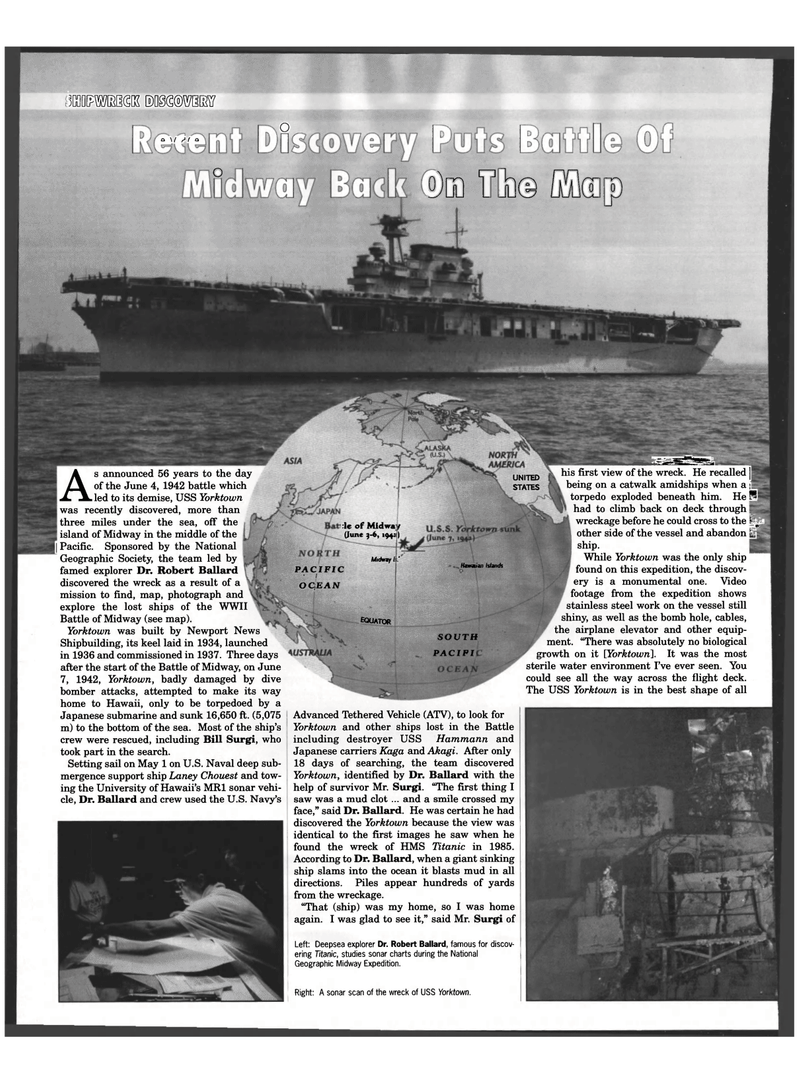
Page 18: of Maritime Reporter Magazine (July 1998)
Read this page in Pdf, Flash or Html5 edition of July 1998 Maritime Reporter Magazine
UNITED
STATES :le of Midway (June j-6, 194a)
M/dwy ft.'
Htwaim Islands PACIFIC , • I
OCjEAN
EQUATOR
SOUTH
PACIFI
MOPMGK MWW * \f S-f a o o !)m ^Gq© ffllap
As announced 56 years to the day of the June 4, 1942 battle which led to its demise, USS Yorktown was recently discovered, more than three miles under the sea, off the island of Midway in the middle of the j Pacific. Sponsored by the National
Geographic Society, the team led by famed explorer Dr. Robert Ballard discovered the wreck as a result of a mission to find, map, photograph and explore the lost ships of the WWII
Battle of Midway (see map).
Yorktown was built by Newport News
Shipbuilding, its keel laid in 1934, launched in 1936 and commissioned in 1937. Three days after the start of the Battle of Midway, on June 7, 1942, Yorktown, badly damaged by dive bomber attacks, attempted to make its way home to Hawaii, only to be torpedoed by a
Japanese submarine and sunk 16,650 ft. (5,075 m) to the bottom of the sea. Most of the ship's crew were rescued, including Bill Surgi, who took part in the search.
Setting sail on May 1 on U.S. Naval deep sub- mergence support ship Laney Chouest and tow- ing the University of Hawaii's MR1 sonar vehi- cle, Dr. Ballard and crew used the U.S. Navy's u 1,
BIBB his first view of the wreck. He recalled j being on a catwalk amidships when a ; torpedo exploded beneath him. He L had to climb back on deck through wreckage before he could cross to the fig® other side of the vessel and abandon p ship.
While Yorktown was the only ship found on this expedition, the discov- ery is a monumental one. Video footage from the expedition shows stainless steel work on the vessel still shiny, as well as the bomb hole, cables, the airplane elevator and other equip- ment. "There was absolutely no biological growth on it [Yorktown], It was the most sterile water environment I've ever seen. You could see all the way across the flight deck.
The USS Yorktown is in the best shape of all
Advanced Tethered Vehicle (ATV), to look for
Yorktown and other ships lost in the Battle including destroyer USS Hammann and
Japanese carriers Kaga and Akagi. After only 18 days of searching, the team discovered
Yorktown, identified by Dr. Ballard with the help of survivor Mr. Surgi. "The first thing I saw was a mud clot ... and a smile crossed my face," said Dr. Ballard. He was certain he had discovered the Yorktown because the view was identical to the first images he saw when he found the wreck of HMS Titanic in 1985.
According to Dr. Ballard, when a giant sinking ship slams into the ocean it blasts mud in all directions. Piles appear hundreds of yards from the wreckage. "That (ship) was my home, so I was home again. I was glad to see it," said Mr. Surgi of
Left: Deepsea explorer Dr. Robert Ballard, famous for discov- ering Titanic, studies sonar charts during the National
Geographic Midway Expedition.
Right: A sonar scan of the wreck of USS Yorktown.

 17
17

 19
19
